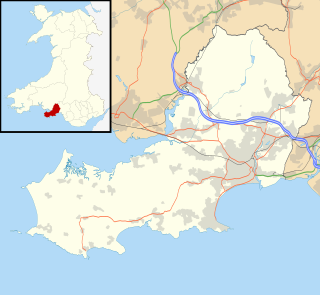Related Research Articles

Glanamman is a Welsh mining village in the valley of the River Amman in Carmarthenshire. Glanamman has long been a stronghold of the Welsh language; village life is largely conducted in Welsh. Like the neighbouring village of Garnant it experienced a coal-mining boom in the 19th and early 20th centuries, but the last big colliery closed in 1947 and coal has been extracted fitfully since then.

The River Tawe is a 30 miles (48 km) long river in South Wales. Its headwaters flow initially east from its source below Llyn y Fan Fawr south of Moel Feity in the Black Mountains, the westernmost range of the Brecon Beacons National Park, before the river turns south and then southwest to its estuary at Swansea. Its main tributaries are the right bank Upper and Lower Clydach Rivers and the Afon Twrch. The total area of the catchment is some 246 km2 (95 sq mi). The Tawe passes through a number of towns and villages including Ystradgynlais, Ystalyfera, Pontardawe, and Clydach and meets the sea at Swansea Bay below Swansea. The Tawe Valley is more commonly known as the Swansea Valley.

The Swansea Vale Railway (SVR) was a railway line connecting the port of Swansea in South Wales to industries and coalfields along the River Tawe on the northern margin of Swansea, by taking over a tramroad in 1846. It was extended to Brynamman in 1868. Passengers were carried from 1860, and a loop line through Morriston was built.

Singleton Hospital is a general hospital in Sketty Lane, Swansea, Wales. It is managed by Swansea Bay University Health Board.

Morriston is a community in the City and County of Swansea, Wales and falls within the Morriston ward. It is the largest community in Swansea county.

Cockett is a district and community in Swansea, Wales falling within Cockett ward. It is located about 1.5 miles (2.4 km) north-west of Swansea city centre.

Llansamlet railway station is a minor station in Llansamlet, Swansea, south Wales. The station is located below street level at Frederick Place in Peniel Green, 212 miles 8 chains (341 km) from London Paddington. It is served by local trains operated by Transport for Wales on the South Wales Main Line between Swansea and Cardiff.

Gowerton railway station serves the village of Gowerton, Wales. It is located at street level at the end of Station Road in Gowerton 5 1⁄2 miles (8.9 km) west of Swansea. The station is unmanned but has a ticket machine, shelters on each platform and live train running information displays.

The Swansea Canal was a canal constructed by the Swansea Canal Navigation Company between 1794 and 1798, running for 16.5 miles (26.6 km) from Swansea to Hen Neuadd, Abercraf in South Wales. It was steeply graded, and 36 locks were needed to enable it to rise 373 feet (114 m) over its length. The main cargos were coal, iron and steel, and the enterprise was profitable.
The Amman Valley Railway Society is situated near the former Gwaun Cae Gurwen branch line, that runs alongside the River Amman, some 10 miles (16 km) north of Swansea in west Wales. Its primary focus is to construct Swansea 9 Lines, an eco-friendly tram system to the heart of Swansea and the surrounding areas. The project was originally based on a heritage railway proposal on a lines that formerly served the various collieries of the area north of Swansea and Llanelli.

ftrmetro Swansea is a bus rapid transit route in Swansea, Wales. The route was served by FTR articulated buses in an attempt to relieve traffic congestion and provide alternative transport to cars, before they were withdrawn in 2015 in favour of smaller-capacity buses.
The Swansea District line is a section of railway line running through the northern part of Swansea, and is primarily used for freight transportation, although minimal passenger services also traverse the route. It was built by the Great Western Railway in 1912 to provide a faster and less steeply graded route between London and Fishguard, in connection with the recently opened harbour at the latter place. It can thereby claim to be the last mainline railway to have been built in Wales. The double track line runs from Cwrt Sart junction at Briton Ferry on the South Wales Main Line to Morlais junction near Pontarddulais on the Heart of Wales line.
National Cycle Route 4 is a route of the National Cycle Network, running from London to Fishguard. Between London and Fishguard, the route runs through Reading, Bath, Bristol, Newport, Swansea, Llanelli and St David's. Within Wales, NCR 4 forms one of the branches of the Celtic Trail cycle route.
The Swansea Improvements and Tramway Company operated street trams in and around Swansea in Wales from 1878 to 1937.
Streetly railway station is a disused station on the Midland Railway in England. It was opened in 1879 and closed in 1965, although the track through the station is still in use for freight.
Church Road Garston railway station was a station in Garston, Liverpool in England, it was situated on the west side of Church Road.
Swansea Bay Metro is a proposed railway enhancement around the Swansea Bay area of South Wales. The project could take up to 10 years to complete.
Landore High Level railway station was opened on 19 June 1850 by the South Wales Railway, which later became part of the Great Western Railway. The station was located on the north side of Swansea in the residential area of Landore. The engineer of this broad gauge line was Brunel. The line was later extended westwards to Carmarthen. After closure of Landore Low Level in 1954 the station became known as Landore.
References
- ↑ "Disused Stations: Morriston West". Disused Stations. Retrieved 9 September 2017.